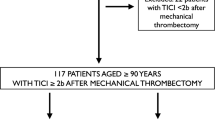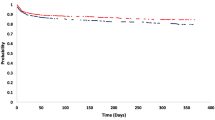Abstract
Objective
This study aimed to evaluate the feasibility and safety values of activated clotting time (ACT)–guided systemic heparinization in reducing periprocedural thrombosis and bleeding complications during coil embolization of unruptured intracranial aneurysms.
Methods
A total of 228 procedures performed on 213 patients between 2016 and 2021 were included in the retrospective analysis. The target ACT was set at 250 s. Logistic regression was performed to assess predictors for the occurrence of thrombosis and bleeding. Receiver operating characteristic (ROC) analyses were employed to determine the optimal cut-off values for ACT, heparinization, and procedure time.
Results
Most (85.1%) of procedures were stent-assisted embolization. The mean baseline ACT was 128.8 ± 45.7 s. The mean ACT at 20 min after the initial intravenous heparin loading of 78.2 ± 18.8 IU/kg was 185 ± 46.4 s. The mean peak ACT was 255.6 ± 63.8 s with 51.3% (117 cases) achieving the target ACT level. Peak ACT was associated with symptomatic thrombosis (OR per second, 1.008; 95% CI, 1.000–1.016; P = 0.035) (cut-off value, 275 s; area under ROC (AUROC), 0.7624). Total administered heparin dose per body weight was negatively associated with symptomatic thrombosis (OR per IU/kg, 0.972; 95% CI, 0.949–0995; P = 0.018) (cut-off value, 294 IU/kg; AUROC, 0.7426) but positively associated with significant bleeding (OR, 1.008 per IU/kg; 95% CI, 1.005–1.012; P <0 .001) (cut-off value, 242 IU/kg; AUROC, 0.7391). Procedure time was significantly associated with symptomatic thrombosis (OR per minute, 1.05; 95% CI, 1.017–1.084; P value = 0.002) (cut-off value, 158 min; area under ROC, 0.8338).
Conclusion
This study demonstrated that ACT-guided systemic heparinization was feasible to achieve the target ACT value and proposes probable safety thresholds to prevent periprocedural complications through reducing procedure time during coil embolization of unruptured intracranial aneurysms in the stent era.





Similar content being viewed by others
Data availability
Not applicable.
Data sharing
None.
References
Almekhlafi MA, Al Sultan AS, Kuczynski AM, Brinjikji W, Menon BK, Hill MD, Goyal M (2020) Antiplatelet therapy for prevention of thromboembolic complications in coiling-only procedures for unruptured brain aneurysms. J Neurointerv Surg 12:298–302. https://doi.org/10.1136/neurintsurg-2019-015173
Bendszus M, Koltzenburg M, Bartsch AJ, Goldbrunner R, Gunthner-Lengsfeld T, Weilbach FX, Roosen K, Toyka KV, Solymosi L (2004) Heparin and air filters reduce embolic events caused by intra-arterial cerebral angiography: a prospective, randomized trial. Circulation 110:2210–2215. https://doi.org/10.1161/01.CIR.0000144301.82391.85
Bertrand OF, Larose E, Rodés-Cabau J, Rinfret S, Déry JP, Bagur R, Gleeton O, Nguyen CM, Proulx G, De Larochellière R, Poirier P, Costerousse O, Roy L (2010) Incidence, range, and clinical effect of hemoglobin changes within 24 hours after transradial coronary stenting. Am J Cardiol 106:155–161. https://doi.org/10.1016/j.amjcard.2010.03.013
Bittl JA, Strony J, Brinker JA, Ahmed WH, Meckel CR, Chaitman BR, Maraganore J, Deutsch E, Adelman B (1995) Treatment with bivalirudin (Hirulog) as compared with heparin during coronary angioplasty for unstable or postinfarction angina. Hirulog Angioplasty Study Investigators. N Engl J Med 333:764–769. https://doi.org/10.1056/NEJM199509213331204
Bond KM, Brinjikji W, Murad MH, Kallmes DF, Cloft HJ, Lanzino G (2017) Diffusion-weighted imaging-detected ischemic lesions following endovascular treatment of cerebral aneurysms: a systematic review and meta-analysis. AJNR Am J Neuroradiol 38:304–309. https://doi.org/10.3174/ajnr.A4989
Bracard S, Barbier C, Derelle AL, Anxionnat R (2013) Endovascular treatment of aneurisms: pre, intra and post operative management. Eur J Radiol 82:1633–1637. https://doi.org/10.1016/j.ejrad.2013.02.012
Brener SJ, Moliterno DJ, Lincoff AM, Steinhubl SR, Wolski KE, Topol EJ (2004) Relationship between activated clotting time and ischemic or hemorrhagic complications: analysis of 4 recent randomized clinical trials of percutaneous coronary intervention. Circulation 110:994–998. https://doi.org/10.1161/01.CIR.0000139868.53594.24
Castellan L, Causin F, Danieli D, Perini S (2003) Carotid stenting with filter protection. Correlation of ACT values with angiographic and histopathologic findings. Neuroradiol J = Journal de neuroradiologie 30:103–108
Choi J, Koo Y, Whang K, Cho S, Kim J (2021) Safety of heparin loading during endovascular embolization in patients with aneurysmal subarachnoid hemorrhage. Clin Neurol Neurosurg 201:106453. https://doi.org/10.1016/j.clineuro.2020.106453
Doganer O, Wiersema AM, Pierie M, Blankensteijn JD, Yeung KK, Jongkind V (2021) More effective anticoagulation during non-cardiac arterial procedures using activated clotting time guided heparin administration. Ann Vasc Surg 76:378–388. https://doi.org/10.1016/j.avsg.2021.04.023
Dutsch A, Graesser C, Voll F, Novacek S, Eggerstedt R, Armbruster NL, Laugwitz KL, Cassese S, Schunkert H, Ndrepepa G, Kastrati A, Kessler T, Sager HB (2022) Association of in-hospital hemoglobin drop with decreased myocardial salvage and increased long-term mortality in patients with acute ST-segment-elevation myocardial infarction. J Am Heart Assoc 11:e024857. https://doi.org/10.1161/jaha.121.024857
Ferguson JJ, Dougherty KG, Gaos CM, Bush HS, Marsh KC, Leachman DR (1994) Relation between procedural activated coagulation time and outcome after percutaneous transluminal coronary angioplasty. J Am Coll Cardiol 23:1061–1065. https://doi.org/10.1016/0735-1097(94)90590-8
Fuchs S, Kornowski R, Teplitsky I, Brosh D, Lev E, Vaknin-Assa H, Ben-Dor I, Iakobishvili Z, Rechavia E, Battler A, Assali A (2009) Major bleeding complicating contemporary primary percutaneous coronary interventions-incidence, predictors, and prognostic implications. Cardiovascular Revascularization Medicine: Including Molecular Interventions 10:88–93. https://doi.org/10.1016/j.carrev.2008.08.001
Hirsh J, Anand SS, Halperin JL, Fuster V, American Heart A (2001) AHA Scientific Statement: Guide to anticoagulant therapy: heparin: a statement for healthcare professionals from the American Heart Association. Arterioscler Thromb Vasc Biol 21:E9–E9. https://doi.org/10.1161/hq0701.093520
Jiang WJ, Wang YJ, Du B, Wang SX, Wang GH, Jin M, Dai JP (2004) Stenting of symptomatic M1 stenosis of middle cerebral artery: an initial experience of 40 patients. Stroke 35:1375–1380. https://doi.org/10.1161/01.STR.0000128018.57526.3a
Kessler IM, Mounayer C, Piotin M, Spelle L, Vanzin JR, Moret J (2005) The use of balloon-expandable stents in the management of intracranial arterial diseases: a 5-year single-center experience. AJNR Am J Neuroradiol 26:2342–2348
Kim DJ, Lee BH, Kim DI, Shim WH, Jeon P, Lee TH (2005) Stent-assisted angioplasty of symptomatic intracranial vertebrobasilar artery stenosis: feasibility and follow-up results. AJNR Am J Neuroradiol 26:1381–1388
Knight CJ, Panesar M, Wilson DJ, Patrineli A, Chronos N, Wright C, Clarke D, Patel D, Fox K, Goodall AH (1998) Increased platelet responsiveness following coronary stenting. Heparin as a possible aetiological factor in stent thrombosis. Eur Heart J 19:1239–1248. https://doi.org/10.1053/euhj.1998.1047
Koh JS, Hwang G, Park JC, Lee CY, Chung J, Lee SW, Kwon HJ, Kim SR, Kang DH, Kwon SC, Kim ST, Chang CH, Jang DK, Choi JH, Kim YW, Kim BT, Shin BG, You SH, Chung SY et al (2023) Tailored antiplatelet therapy in stent assisted coiling for unruptured aneurysms: a nationwide registry study. J Neurointerv Surg. https://doi.org/10.1136/jnis-2022-019571
Lawton JS, Tamis-Holland JE, Bangalore S, Bates ER, Beckie TM, Bischoff JM, Bittl JA, Cohen MG, DiMaio JM, Don CW, Fremes SE, Gaudino MF, Goldberger ZD, Grant MC, Jaswal JB, Kurlansky PA, Mehran R, Metkus TS Jr, Nnacheta LC et al (2022) 2021 ACC/AHA/SCAI guideline for coronary artery revascularization: executive summary: a report of the American College of Cardiology/American Heart Association Joint Committee on Clinical Practice Guidelines. Circulation 145:e4–e17. https://doi.org/10.1161/CIR.0000000000001039
Lee SH, Jang MU, Kang J, Kim YJ, Kim C, Sohn JH, Yang J, Jeon JP, Cho Y, Choi HJ (2018) Impact of reducing the procedure time on thromboembolism after coil embolization of cerebral aneurysms. Front Neurol 9:1125. https://doi.org/10.3389/fneur.2018.01125
Levy EI, Boulos AS, Guterman LR (2002) Stent-assisted endoluminal revascularization for the treatment of intracranial atherosclerotic disease. Neurol Res 24:337–346. https://doi.org/10.1179/016164102101200113
Lim Fat MJ, Al-Hazzaa M, Bussiere M, dos Santos MP, Lesiuk H, Lum C (2013) Heparin dosing is associated with diffusion weighted imaging lesion load following aneurysm coiling. J Neurointerv Surg 5:366–370. https://doi.org/10.1136/neurintsurg-2011-010225
Lylyk P, Cohen JE, Ceratto R, Ferrario A, Miranda C (2002) Endovascular reconstruction of intracranial arteries by stent placement and combined techniques. J Neurosurg 97:1306–1313. https://doi.org/10.3171/jns.2002.97.6.1306
Mascelli MA, Kleiman NS, Marciniak SJ Jr, Damaraju L, Weisman HF, Jordan RE (2000) Therapeutic heparin concentrations augment platelet reactivity: implications for the pharmacologic assessment of the glycoprotein IIb/IIIa antagonist abciximab. Am Heart J 139:696–703. https://doi.org/10.1016/s0002-8703(00)90050-4
Mascitelli JR, Moyle H, Oermann EK, Polykarpou MF, Patel AA, Doshi AH, Gologorsky Y, Bederson JB, Patel AB (2015) An update to the Raymond-Roy Occlusion Classification of intracranial aneurysms treated with coil embolization. J Neurointerv Surg 7:496–502. https://doi.org/10.1136/neurintsurg-2014-011258
McGarry TF Jr, Gottlieb RS, Morganroth J, Zelenkofske SL, Kasparian H, Duca PR, Lester RM, Kreulen TH (1992) The relationship of anticoagulation level and complications after successful percutaneous transluminal coronary angioplasty. Am Heart J 123:1445–1451. https://doi.org/10.1016/0002-8703(92)90793-u
Mo L, Yue J, Yu W, Liu X, Tan C, Peng W, Ding X, Chen L (2022) Diffusion-weighted imaging lesions after endovascular treatment of cerebral aneurysms: a network meta-analysis. Front Surg 9:964191. https://doi.org/10.3389/fsurg.2022.964191
Morabia A (1986) Heparin doses and major bleedings. Lancet 1:1278–1279. https://doi.org/10.1016/s0140-6736(86)91421-2
Mottillo S, Filion KB, Joseph L, Eisenberg MJ (2017) Defining optimal activated clotting time for percutaneous coronary intervention: a systematic review and Bayesian meta-regression. Catheter Cardiovasc Interv 89:351–366. https://doi.org/10.1002/ccd.26652
Narins CR, Hillegass WB Jr, Nelson CL, Tcheng JE, Harrington RA, Phillips HR, Stack RS, Califf RM (1996) Relation between activated clotting time during angioplasty and abrupt closure. Circulation 93:667–671. https://doi.org/10.1161/01.cir.93.4.667
O'Gara PT, Kushner FG, Ascheim DD, Casey DE Jr, Chung MK, de Lemos JA, Ettinger SM, Fang JC, Fesmire FM, Franklin BA, Granger CB, Krumholz HM, Linderbaum JA, Morrow DA, Newby LK, Ornato JP, Ou N, Radford MJ, Tamis-Holland JE et al (2013) 2013 ACCF/AHA guideline for the management of ST-elevation myocardial infarction: a report of the American College of Cardiology Foundation/American Heart Association Task Force on Practice Guidelines. Circulation 127:e362–e425. https://doi.org/10.1161/CIR.0b013e3182742cf6
Oshita J, Sakamoto S, Matsushige T, Okazaki T, Ishii D, Kawano R, Kurisu K (2019) Factors other than body weight predicting heparin loading to acquire optimal activated clotting time in endovascular neurointerventions. Clin Neurol Neurosurg 184:105422. https://doi.org/10.1016/j.clineuro.2019.105422
Park JC, Lee DH, Kim JK, Ahn JS, Kwun BD, Kim DY, Choi CG (2016) Microembolism after endovascular coiling of unruptured cerebral aneurysms: incidence and risk factors. J Neurosurg 124:777–783. https://doi.org/10.3171/2015.3.Jns142835
Scharf J, Dempfle CE (2012) Anticoagulation in neurointerventions: basic pharmacology and pathophysiology, current status, practical advice. Clin Neuroradiol 22:3–13. https://doi.org/10.1007/s00062-012-0133-6
Wiersema AM, Roosendaal LC, Koelemaij MJW, Tijssen JGP, van Dieren S, Blankensteijn JD, Debus ES, Middeldorp S, Heyligers JMM, Fokma YS, Reijnen M, Jongkind V (2021) ACTION-1: study protocol for a randomised controlled trial on ACT-guided heparinization during open abdominal aortic aneurysm repair. Trials 22:639. https://doi.org/10.1186/s13063-021-05552-7
Xiao Z, Theroux P (1998) Platelet activation with unfractionated heparin at therapeutic concentrations and comparisons with a low-molecular-weight heparin and with a direct thrombin inhibitor. Circulation 97:251–256. https://doi.org/10.1161/01.cir.97.3.251
Zhang L, Zhou X, Liu Y, Ding C, Wang Y, Yang H (2020) The utility of diffusion-weighted MRI lesions to compare the effects of different heparinization schemes in intracranial aneurysms treated by endovascular intervention. Front Neurol 11:609384. https://doi.org/10.3389/fneur.2020.609384
Acknowledgements
The authors give special thanks to all dedicated members of the neurointervention team at the authors’ center.
Author information
Authors and Affiliations
Contributions
Conceptualization: DKJ; data curation: HJ, DKJ; formal analysis: DKJ; methodology: DKJ; project administration: DKJ; visualization: DKJ; writing original draft: HJ, BRC, DKJ, DSK; writing review and editing; HJ, BRC, DKJ, DSK; HJ and BRC equally contributed to the manuscript writing.
Corresponding author
Ethics declarations
Ethics approval
All procedures performed in studies involving human participants were in accordance with the ethical standards of the institutional and/or national research committee and with the 1964 Helsinki declaration and its later amendments or comparable ethical standards.
Consent to participate
For this type of study, formal consent is not required.
Consent for publication
For this type of study, formal consent is not required.
Preprint
None.
Conflict of interest
The authors declare no competing interests.
Additional information
Publisher’s note
Springer Nature remains neutral with regard to jurisdictional claims in published maps and institutional affiliations.
Rights and permissions
Springer Nature or its licensor (e.g. a society or other partner) holds exclusive rights to this article under a publishing agreement with the author(s) or other rightsholder(s); author self-archiving of the accepted manuscript version of this article is solely governed by the terms of such publishing agreement and applicable law.
About this article
Cite this article
Jang, H., Cho, BR., Jang, DK. et al. Feasibility and safety values of activated clotting time–guided systemic heparinization in coil embolization for unruptured intracranial aneurysms. Acta Neurochir 165, 3743–3757 (2023). https://doi.org/10.1007/s00701-023-05869-z
Received:
Accepted:
Published:
Issue Date:
DOI: https://doi.org/10.1007/s00701-023-05869-z




